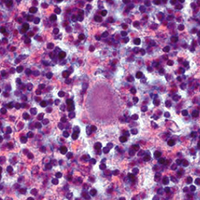Sporadic Creutzfeldt-Jakob disease: Real-Time Quaking Induced Conversion (RT-QuIC) assay represents a major diagnostic advance

Accepted: 7 September 2021
HTML: 24
All claims expressed in this article are solely those of the authors and do not necessarily represent those of their affiliated organizations, or those of the publisher, the editors and the reviewers. Any product that may be evaluated in this article or claim that may be made by its manufacturer is not guaranteed or endorsed by the publisher.
Authors
Sporadic Creutzfeldt-Jakob disease (sCJD) is a rare and fatal neurodegenerative disorder with an incidence of 1.5 to 2 cases per million population/year. The disease is caused by a proteinaceous infectious agent, named prion (or PrPSc), which arises from the conformational conversion of the cellular prion protein (PrPC). Once formed, PrPSc interacts with the normally folded PrPC coercing it to undergo similar structural rearrangement. The disease is highly heterogeneous from a clinical and neuropathological point of view. The origin of this variability lies in the aberrant structures acquired by PrPSc. At least six different sCJD phenotypes have been described and each of them is thought to be caused by a peculiar PrPSc strain. Definitive sCJD diagnosis requires brain analysis with the aim of identifying intracerebral accumulation of PrPSc which currently represents the only reliable biomarker of the disease. Clinical diagnosis of sCJD is very challenging and is based on the combination of several clinical, instrumental and laboratory tests representing surrogate disease biomarkers. Thanks to the advent of the ultrasensitive Real-Time Quaking-Induced Conversion (RT-QuIC) assay, PrPSc was found in several peripheral tissues of sCJD patients, sometimes even before the clinical onset of the disease. This discovery represents an important step forward for the clinical diagnosis of sCJD. In this manuscript, we present an overview of the current applications and future perspectives of RT-QuIC in the field of sCJD diagnosis.
How to Cite

This work is licensed under a Creative Commons Attribution-NonCommercial 4.0 International License.
PAGEPress has chosen to apply the Creative Commons Attribution NonCommercial 4.0 International License (CC BY-NC 4.0) to all manuscripts to be published.
Similar Articles
- M. Costanzo, B. Cisterna, A. Vella, T. Cestari, V. Covi, G. Tabaracci, M. Malatesta, Low ozone concentrations stimulate cytoskeletal organization, mitochondrial activity and nuclear transcription , European Journal of Histochemistry: Vol. 59 No. 2 (2015)
- Gong Cheng, Fengmin An, Zhilin Cao, Mingdi Zheng, Zhongyuan Zhao, Hao Wu, DPY30 promotes the growth and survival of osteosarcoma cell by regulating the PI3K/AKT signal pathway , European Journal of Histochemistry: Vol. 67 No. 1 (2023)
- Manuela Monti, Perinatal Stem Cells - Biology, Manufacturing and Translational Medicine , European Journal of Histochemistry: Vol. 65 No. 3 (2021)
- Letizia Ferroni, Chiara Gardin, Andrea De Pieri, Maria Sambataro, Elena Seganfreddo, Chiara Goretti, Elisabetta Iacopi, Barbara Zavan, Alberto Piaggesi, Treatment of diabetic foot ulcers with Therapeutic Magnetic Resonance (TMR®) improves the quality of granulation tissue , European Journal of Histochemistry: Vol. 61 No. 3 (2017)
- Wei Wang, Wenbo Tang, Erbo Shan, Lei Zhang, Shiyuan Chen, Chaowen Yu, Yong Gao, MiR-130a-5p contributed to the progression of endothelial cell injury by regulating FAS , European Journal of Histochemistry: Vol. 66 No. 2 (2022)
- Chaoyong Tian, Yang Yang, Yao Li, Fei Sun, Juan Qu, Dingjun Zha, Expression and localization of α2A-adrenergic receptor in the rat post-natal developing cochlea , European Journal of Histochemistry: Vol. 67 No. 3 (2023)
- A. Porzionato, V. Macchi, A. Amagliani, I. Castagliuolo, A. Parenti, R. De Caro, Neurotensin receptor 1 immunoreactivity in the peripheral ganglia and carotid body , European Journal of Histochemistry: Vol. 53 No. 3 (2009)
- R Pennati, S Groppelli, F De Bernardi, F Mastrototaro, G Zega, Immunohistochemical analysis of adhesive papillae of Clavelina lepadiformis (Müller, 1776) and Clavelina phlegraea (Salfi, 1929) (Tunicata, Ascidiacea) , European Journal of Histochemistry: Vol. 53 No. 1 (2009)
- E. Wyroba, P. Kwaśniak, K. Miller, K. Kobyłecki, M. Osińska, Site-directed mutagenesis, in vivo electroporation and mass spectrometry in search for determinants of the subcellular targeting of Rab7b paralogue in the model eukaryote Paramecium octaurelia , European Journal of Histochemistry: Vol. 60 No. 2 (2016)
- C. Pellicciari, M. Malatesta, Identifying pathological biomarkers: histochemistry still ranks high in the omics era , European Journal of Histochemistry: Vol. 55 No. 4 (2011)
<< < 18 19 20 21 22 23 24 25 26 27 > >>
You may also start an advanced similarity search for this article.

 https://doi.org/10.4081/ejh.2021.3298
https://doi.org/10.4081/ejh.2021.3298










